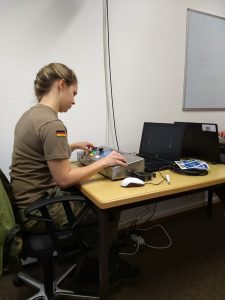Quasi-experimental study on the relationship between high sensitivity and attention.




If you would like to participate in the EHA study, please contact eha-studie@hsu-hh.de to make an appointment.
The EHA study is a collaborative project of M.Sc. Marcus Bürger and Mag. Johann-Christoph Münscher. We are research assistants (PhD students) of the Chair of Psychological Diagnostics and Personality Psychology.
- The internal ethics committee of the Helmut Schmidt University has reviewed the survey and confirmed its implementation.
- The EHA study is partially supported by the Freunde und Förderer der Helmut-Schmidt-Universität / Universität der Bundeswehr Hamburg e.V. through financial means. We would like to express our gratitude for this support.
- Marcus Bürger (M.Sc.) was supported by a nanostipend from the Informations- und Forschungsverbund Hochsensibilität e.V. (for information on this association, please visit www.hochsensibel.org).
- The study includes an on-site survey as well as a survey via smartphone. Information about the mobile part of the project can be found HERE.
- The controls used in the laboratory study were designed at the Chair of Personality Psychology and developed and constructed in collaboration with the Central Workshop.
- Further information on the data protection and hygiene concept can be found at the bottom of this page.
Two different research strands are highlighted below as origins of the joint research ambitions.
- High sensitivity as a psychological construct to describe interindividual differences in the perception and processing of environmental stimuli.
- The development and testing of an innovative measurement method for continuous attention measurement.
High sensitivity (sensory-processing sensitivity) as a construct for describing interindividual differences in environmental sensitivity.
All human beings live in an environment (co-environment) which can be experienced and processed with different intensity depending on the psychological constitution and situation. In other words, there are interindividual differences in the response to environmental stimuli. Highly sensitive individuals tend to (i) perceive small changes or differences (subtleties) in their environment and thereby (ii) react more emotionally involved than less highly sensitive beings. They feel a great deal of empathy toward other living beings. (iii) Their processing of environmental information is particularly deep, thus often associated with a search for meaning and self-reference. (iv) Accompanying these interindividual differences is a tendency to (physiological) overexcitement and overexcitability (Homberg et al., 2016).
Three theories, which are superordinately referred to as environmental sensitivity theories, describe this phenomenon, each with a discipline-specific focus (Differential Susceptibility (DS), Biological Sensitivity to Context (BSC) & Sensory-Processing Sensitivity (SPS)). For a comprehensive overview, please see Greven et al. (2019). What all theories agree on is the assumption of particular responsiveness to positive and negative environmental stimuli, and a prevalence in the population of 20-30%. SPS is the only theory that defines 4 core aspects, which can be operationalized on behavioral level, among others, and were initially described by Aron & Aron (1997) (see above).
There are numerous sources of information and diverse counseling services on high sensitivity (for example, Aron (2016)). However, empirical research has not yet made an adequate number of systematic observations that would allow for a well-founded, high-sensitivity-specific range of care or counseling services beyond already known, generalized, and effective intervention services. The aim of this study is to provide a sound, basic scientific basis for applied help offers for highly sensitive persons and their specific adaptation difficulties. In addition, it aims to better understand the resources of highly sensitive individuals and thereby promote their potential-developing (vocational) placement (Wyrsch et al., 2020).
Due to the many possible scientific starting points of a relatively unexplored construct, it is necessary to make a selection regarding the partial aspects of interest, taking into account its methodological accessibility. The authors and study leaders consider two core aspects to be particularly fruitful and salient for highly sensitive experiential worlds. Depth of processing (DOP) and the assumed increased predisposition to overexcitability.
Therefore, this part of the study has two core objectives:
- An empirical, laboratory evidence for deep processing of highly sensitive individuals using the classical Stroop paradigm. Assumed to be a significant response time increase in the incongruent condition. The interpretation is analogous to effects of forced reading according to Eidels et al. (2014).
- Characterizing highly sensitive physiological arousal trajectories (operationalized by heart rate variability), highly sensitive attentional trajectories, and their interplay during reaction time task processing (Delliaux et al., 2019).
This is realized by looking at group differences between highly sensitive and less highly sensitive individuals over the course of the study session of approximately 1.25 hours.
Regarding (1): If the expected group differences can be shown in the incongruent condition, evidence for deep processing in highly sensitive individuals could be shown for the first time in a behavioral experiment. Laboratory conditions differ from natural, complex everyday conditions because of the unnatural, controlled stimulus isolation. In the latter everyday context it could already be described qualitatively richly, in which the deep processing of the highly sensitive (search for meaning and self-reference) finds expression. First indications on the usability of behavioral experiments for mapping deep processing would imply a general investigability of the phenomenon and stimulate further research. Can deep processing be influenced (?) and which influencing factors are effective?
Regarding (2): It could be shown whether highly sensitive individuals actually exhibit a quantifiably higher initial arousal, are more quickly aroused when stressed by performance demands, and are ultimately slower to return to an arousal initial state. In addition, the relationship to performance behavior (here: attentional performance) can also be made visible here.
Development and testing of an innovative measurement method for continuous attention measurement

Within the framework of a project for the development of practical methods for the measurement of attention, different task types were developed. The starting point was the effort to develop realistic measurement methods for applications in a professional context. Since many current tests of attention employ abstract items and stimulus material, task and item types with realism were to be developed (Warm et al., 2008). Of the tasks developed, the task type tentatively referred to as the continuous matching task (CMT) is presented. This allows for new approaches and possibilities in terms of implementation and evaluation. The implemented computerized continuous performance measurement allows a measurement with very high temporal resolution, which makes a detailed evaluation of the performance course possible. Except for the instruction, the stimulus material is language-free, easy to understand, cognitively undemanding, and can be combined with other tasks and items, enabling measurement of divided attention (Hirsch et al., 2018). Also novel is the adaptive implementation, where stimulus material is generated in real time based on individual performance levels. This allows for potentially unlimited measurement duration, as well as multiple measurement repetitions (Weiss, 1982).
Testing is conducted using custom-developed hardware and software that allows a variety of characteristics to be operationalized. The measurement data can be analyzed in a variety of ways, and a number of scoring modes and interpretive options are evaluated and presented. In addition to other measures of attention and personality traits, physiological parameters are collected and evaluated (Delliaux et al., 2019). Based on the results of the pilot study, interpretation options, limitations, first indicators of validity, as well as a theoretical classification in models of attention and implications for practical applications will be presented.
The described methods will be implemented in a laboratory study on the one hand, and in a mobile application on the other hand. This approach has two goals. On the one hand, it provides another opportunity for data collection, as the results from both applications are combined. On the other hand, since the material in the mobile application is partly identical to the laboratory investigation, the influence of the investigation environment or the measurement mode becomes possible. Especially recently, especially during the current pandemic situation, testing outside the laboratory using one’s own terminal device has a lot of potential and should be illuminated (Holmlund et al., 2019).
Material
Literature:
- Aron, E. N. (2016). The highly sensitive person: how to thrive when the world overwhelms you. Harmony Books.Aron, E. N., & Aron, A. (1997). Sensory-processing sensitivity and its relation to introversion and emotionality. Journal of Personality and Social Psychology, 73(2), 345–368. https://doi.org/10.1037/0022-3514.73.2.345
- Delliaux, S., Delaforge, A., Deharo, J.-C., & Chaumet, G. (2019). Mental Workload Alters Heart Rate Variability, LoweringNon-linear Dynamics. Frontiers in Physiology, 10. https://doi.org/10.3389/fphys.2019.00565
- Eidels, A., Ryan, K., Williams, P., & Algom, D. (2014). Depth of processing in the stroop task: Evidence from a novel forced-reading condition. Experimental Psychology, 61(5), 385–393. https://doi.org/10.1027/1618-3169/a000259
- Greven, C. U., Lionetti, F., Booth, C., Aron, E. N., Fox, E., Schendan, H. E., Pluess, M., Bruining, H., Acevedo, B., Bijttebier, P., & Homberg, J. (2019). Sensory Processing Sensitivity in thecontext of Environmental Sensitivity: A critical review and development of research agenda. Neuroscience & Biobehavioral Reviews, 98, 287–305. https://doi.org/10.1016/j.neubiorev.2019.01.009
- Hirsch, P., Nolden, S., Declerck, M., & Koch, I. (2018). Common cognitive control processes underlying performance in task-switching and dual-task contexts. Advances in Cognitive Psychology, 14(3), 62–74. https://doi.org/10.5709/acp-0239-y
- Holmlund, T. B., Foltz, P. W., Cohen, A. S., Johansen, H. D., Sigurdsen, R., Fugelli, P., Bergsager, D., Cheng, J., Bernstein, J., Rosenfeld, E., & Elvevåg, B. (2019). Moving psychological assessment out of the controlled laboratory setting: Practical challenges. Psychological Assessment, 31(3), 292–303. https://doi.org/10.1037/pas0000647
- Homberg, J. R., Schubert, D., Asan, E., & Aron, E. N. (2016). Sensory processing sensitivity and serotonin gene variance: Insights into mechanisms shaping environmental sensitivity. In Neuroscience and Biobehavioral Reviews(Vol. 71, pp. 472–483). Elsevier Ltd. https://doi.org/10.1016/j.neubiorev.2016.09.029
- Warm, J. S., Matthews, G., & Finomore, V. (2008). Vigilance, workload, and stress. In Performance under stress(pp. 115–141).Weiss, D. J. (1982). Improving measurement quality and efficiency with adaptive testing. Applied Psychological Measurement, 6(4), 473–492. https://doi.org/10.1177/014662168200600408
- Wyrsch, P. C., de Groote, J. K., & Hack, A. (2020). Hoch (neuro) sensitive Mitarbeitende: Weicheier oder Wunderkinder?.
Letzte Änderung: 11. October 2021
